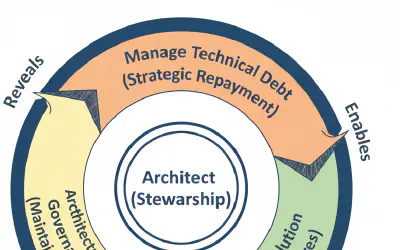The Spike
Where Theory Meets Reality
Part of the From Patterns to Practice series
Introduction: Beyond the Spreadsheet
In our last post, the Weighted Scoring Matrix gave you a data-informed hypothesis: an Event-Driven Architecture was the best fit for CityPulse’s unique drivers. But the victory was by a razor-thin margin, and it came with a huge, unquantified risk: the team’s relative inexperience with asynchronous, distributed systems.
As the architect, you know that when you lack data, you don’t guess. You run an experiment.
This post is about that experiment: the architectural spike. You’ll see how to use a short, time-boxed investigation to move from a risky hypothesis to an evidence-backed decision. This is how you handle uncertainty: you don’t ignore it; you invest in a small, controlled way to “buy information” and reduce it.
Defining the Experiment
A spike is not “go build a prototype.” It’s a focused scientific experiment, and you set clear goals and a strict time limit. For the CityPulse team, you define a two-week time-box with three explicit objectives:
- Build a “Walking Skeleton”: Implement the absolute minimum end-to-end ticket purchase flow: an API Gateway endpoint that sends a message to an Event Broker, which is then consumed by a service that writes to a database.
- Test for “Unknown Unknowns”: The biggest dangers in a new architecture are the problems you don’t know you have yet. You instruct the team to focus on two areas: Can they effectively trace a single request across the system? And what does the debugging experience feel like?
- Assess Team Proficiency: How steep is the learning curve really? Where do the engineers get stuck? This isn’t about judging the team; it’s about honestly measuring the friction of the new paradigm to inform your final decision.
The Logbook: Universal Truths of Event-Driven Systems
The two weeks are a whirlwind of learning. You watch as the team discovers the universal hurdles that any team often faces when adopting EDA for the first time:
- Day 2: The Tooling Problem. The team immediately hits a wall. Their standard, beloved testing libraries have poor support for mocking the event broker, making unit tests for the consumer service difficult and non-intuitive.
- Day 5: The Observability Challenge. A developer accidentally introduces a subtle bug in an event’s data structure. It takes nearly a full day to track down because the request appeared “successful” at the API gateway, but was failing silently in the consumer. They realize they have no way to tie the initial API call to the database write that happened seconds later.
- Day 9: The “Mental Model” Shift. The team has a breakthrough and gets the end-to-end flow working. However, during the review, a senior developer admits, “I’m still struggling to reason about this. The idea that the purchase isn’t ‘done’ when the API call returns is giving me a headache.”
The Verdict: A Fork in the Road
At the end of the two weeks, you convene a retro. The walking skeleton works, but the journey was fraught with friction. The raw data is in, but the data doesn’t make the decision. Now, your job is to interpret that data within the team’s specific context.
This is a fork in the road. To illustrate the power of context, you can map out two distinct, equally valid interpretations of these exact same results.
Path A: The Pragmatic Pivot
(For a team talented in backend development, but new to distributed systems)
- Interpretation: This team looks at the spike’s results and sees significant risk. The testing and debugging friction isn’t just an annoyance; it’s a direct threat to their velocity. The “mental model” shift isn’t a small hurdle; it’s a major source of potential bugs. They conclude that the learning curve is too steep to climb while also trying to meet a critical 3-month business deadline.
- Your Architect's Log might read: “The spike was a huge success. It didn't tell us what we wanted to hear; it told us what we needed to know. It converted the 'unknown' risk of our inexperience into a 'known' and unacceptable one. For our team, right now, the upfront 'complexity tax' of EDA is too high to pay. Charging ahead would be setting the team up for failure.”
- Decision: You make the mature, pragmatic decision to pivot to a well-structured monolith for the initial launch. You direct the team to use the spike’s learnings to design the monolith with clean internal boundaries, ensuring the ticketing component is isolated and can be extracted into a service later.
Path B: The Confident Validation
(For a team with prior experience in microservices and distributed tracing)
- Interpretation: This team sees the same challenges not as blockers, but as familiar, solvable problems. Their reaction is different: “Yes, this is typical for EDA. The testing issue means we need to incorporate a library specifically for mocking event streams. The observability problem means we must enforce a rule that every event carries a ‘Correlation ID’. The ‘mental model’ shift can be addressed with a few team-wide design reviews.”
- In this scenario, your Architect's Log sounds very different: "The spike revealed no surprises. It confirmed the challenges we expected and, more importantly, validated that our existing skills and patterns are sufficient to manage them. The risk is now contained and understood. We are ready to proceed."
- Decision: The spike successfully de-risks the project, giving you the confidence to proceed with the Event-Driven Architecture.
Context is King
The architectural spike is one of the most powerful tools in your toolbox. Its purpose isn’t always to prove your initial hypothesis correct. Its purpose is to replace uncertainty with evidence.
As you’ve seen from the two paths, the same evidence can lead to two different, entirely correct decisions. The crucial variable was the team’s context. Path A wasn’t a “failure,” and Path B wasn’t “smarter.” They were different answers to the same question, tailored to the reality of the people who would have to build and operate the system.
For the remainder of the CityPulse series, we will follow the narrative of Path B, where you and your team proceed with the EDA. This will allow us to explore the next set of challenges in building and operating a modern, distributed system.



